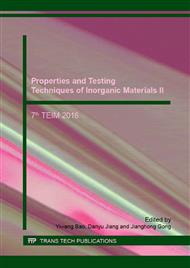[1]
R. Naslain. Design, preparation and properties of non-oxide CMCs for application in engines and nuclear reactors: an overview. Composites Science and Technology, 2004, (64): 155-170.
DOI: 10.1016/s0266-3538(03)00230-6
Google Scholar
[2]
Y. Katoh. Current status and recent research achievements in SiC/SiC composites. 16th International Conference on Fusion Reactor Materials, 2013, Beijing.
Google Scholar
[3]
A. Lacombe, P. Spriet, A. Allaria, E. Bouillon, G. Habarou. Ceramic Matrix Composites to make breakthroughs in aircraft engine performance. 50th AIAA/ASME/ASCE/AHS/ASC Structures, Structural Dynamics, and Materials Conference, 2009, California.
DOI: 10.2514/6.2009-2675
Google Scholar
[4]
S. Labruquere, H. Blanchard, R. Pailler . Enhancement of the Oxidation Resistance of Interfacial Area in C/C composites. Part I: Oxidation Resistance.
Google Scholar
[5]
H. Zhou , L. Gao , Z. Wang . ZrB2–SiC Oxidation Protective Coating on C/C Composites Prepared by Vapour Silicon Infiltration Process. J. Am. Ceram. Soc., 2010, 93(4): 915–919.
DOI: 10.1111/j.1551-2916.2009.03481.x
Google Scholar
[6]
P. R. Romine ,O. O. Ochoa , An Assessment of the Effect of Inhibitor Oxidation on the Response of Oxidation Resistant Carbon/Carbon Composites. Composites Science and Technology, 1996, 56: 569–579.
DOI: 10.1016/0266-3538(96)00044-9
Google Scholar
[7]
D. W. McKee. Oxidation behavior and Protection of Carbon/Carbon Composites. Carbon, 1987, 25(4): 551–557.
DOI: 10.1016/0008-6223(87)90197-7
Google Scholar
[8]
S. H. Lee, M. Weinmann, F. Aldinger. Processing and properties of C/S-B-C-N fiber reinforced ceramic matrix composites prepared by precursor impregnation and pyrolysis. Acta Materialia, 2008, 56: 1529-1538.
DOI: 10.1016/j.actamat.2007.12.001
Google Scholar
[9]
Y. Tang, J. Wang, X. D. L. Thermal stability of polymer derived SiBNC ceramics. Ceramics International, 2009, 35: 2871-2876.
DOI: 10.1016/j.ceramint.2009.03.043
Google Scholar
[10]
L. J. Luo, M. Ge, W. G. Zhang. Pyrolysis synthesis of Si–B–C–N ceramics and the irthermal stability. Ceramics International, 2013, 39: 7903-7909.
DOI: 10.1016/j.ceramint.2013.03.052
Google Scholar
[11]
M. W. Chen, H. P. Qiu,W. J. Xie. Preparation and Properties of SiC/Si-B-C-N Ceramic Composites. Key Engineering Materials, 2016, 697, 489-493.
DOI: 10.4028/www.scientific.net/kem.697.489
Google Scholar
[12]
M. W. Chen, H. P. Qiu, J. Jiao. Thermodynamic Analysis of Chemical Vapor Deposition Progress for SiC Coatings, Key Engineering Materials, 2015, 633: 183-188.
DOI: 10.4028/www.scientific.net/kem.633.183
Google Scholar


